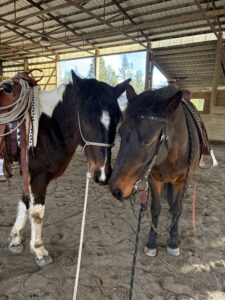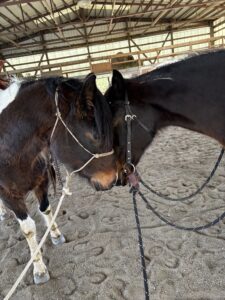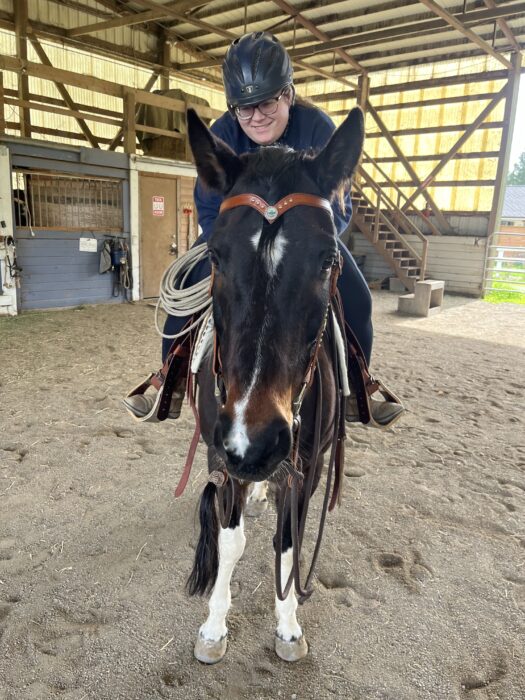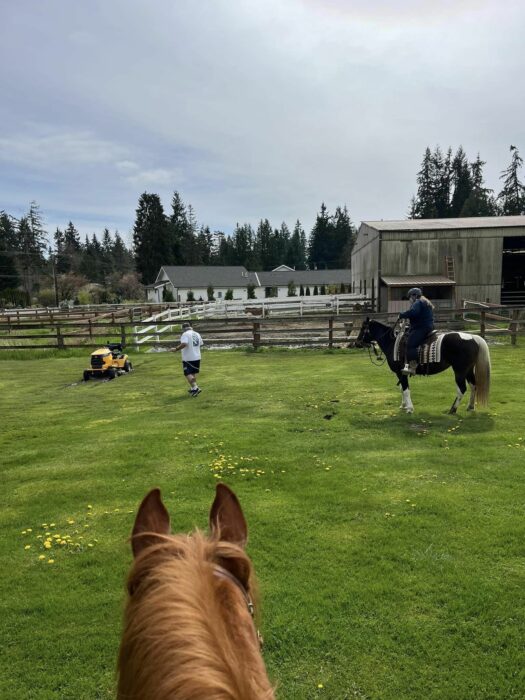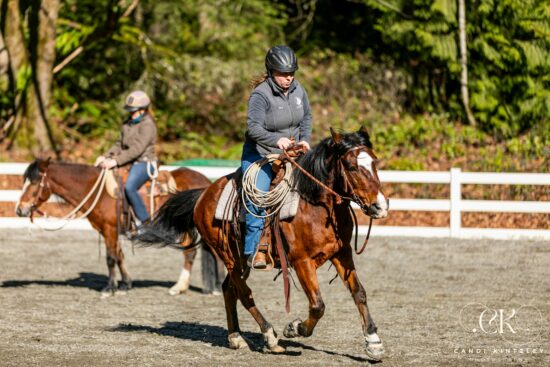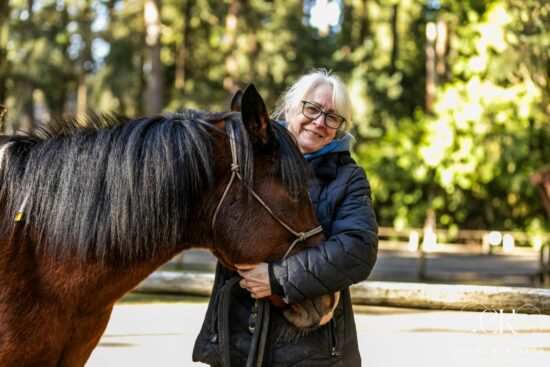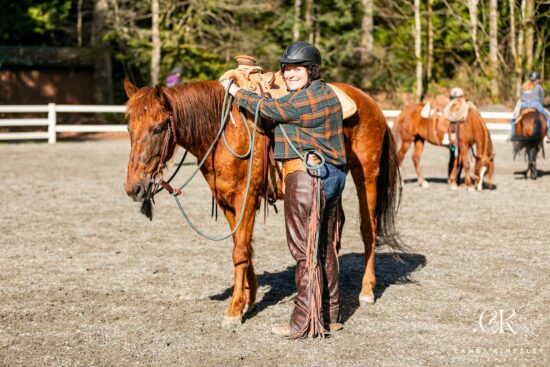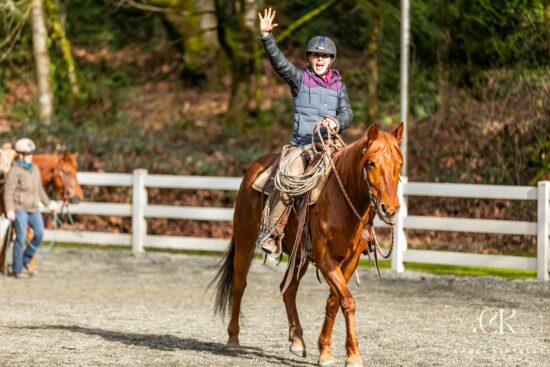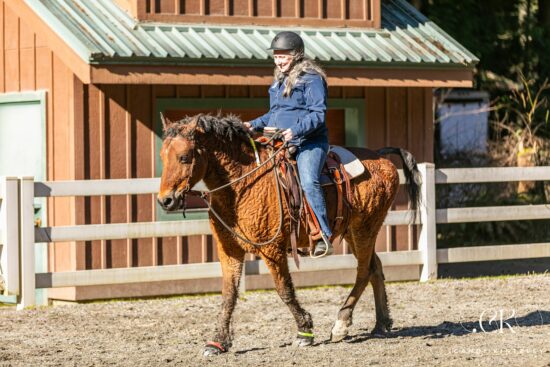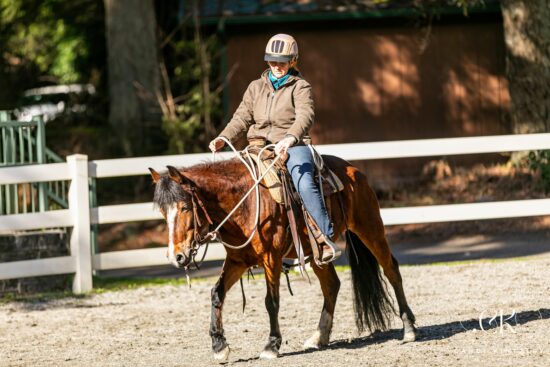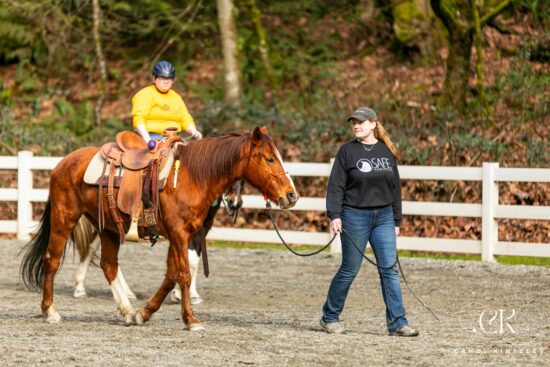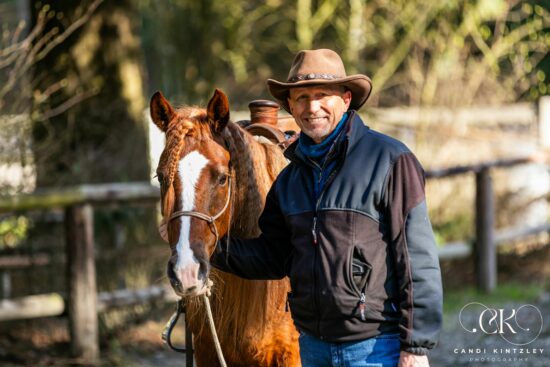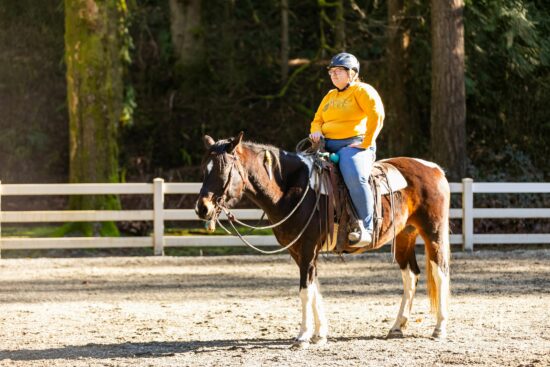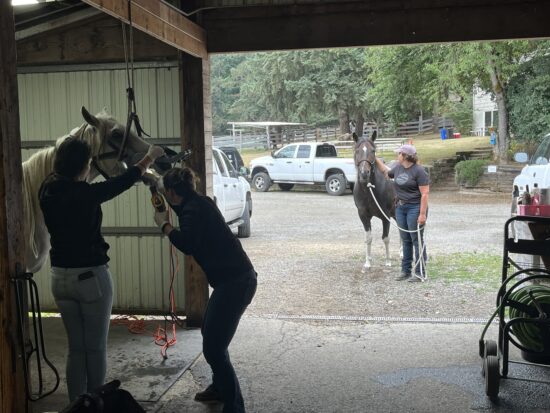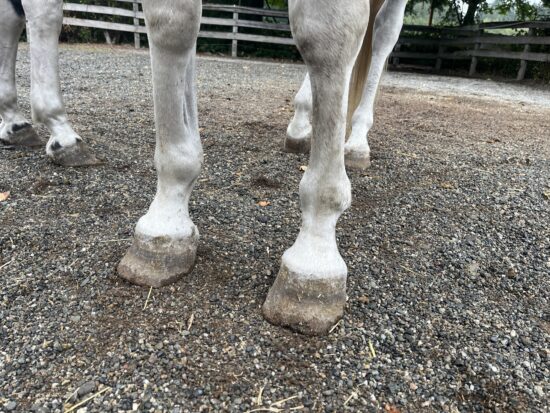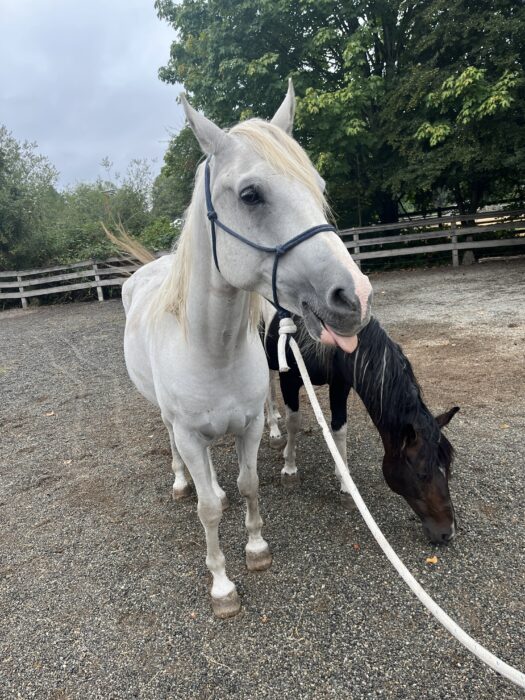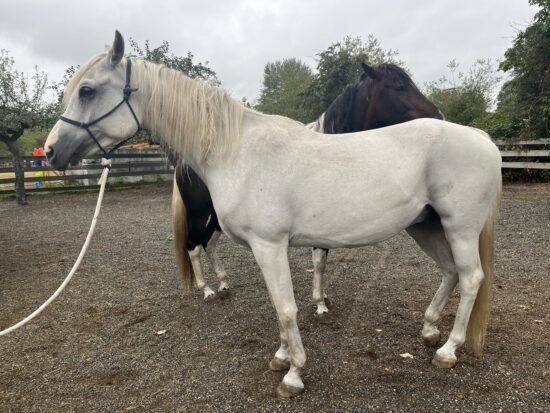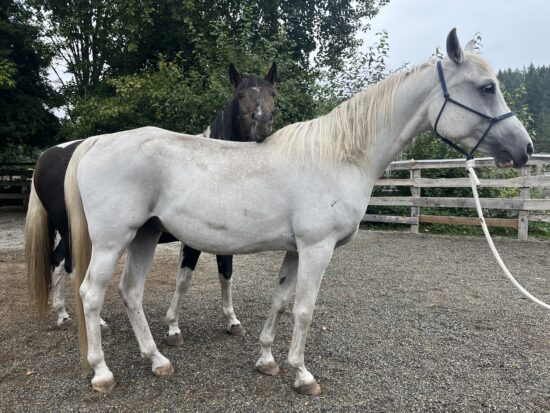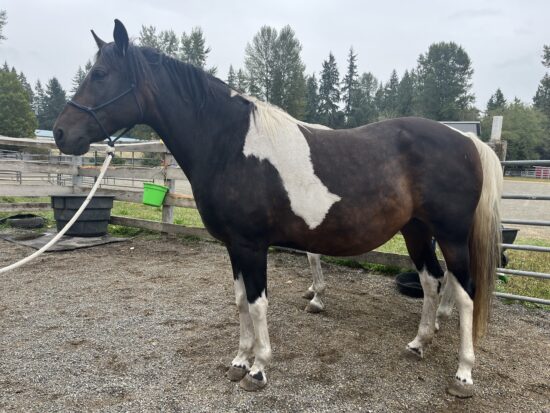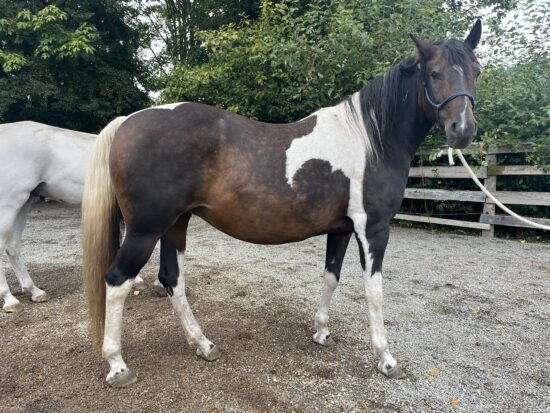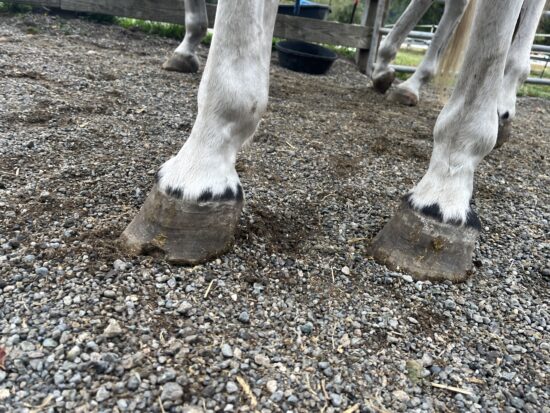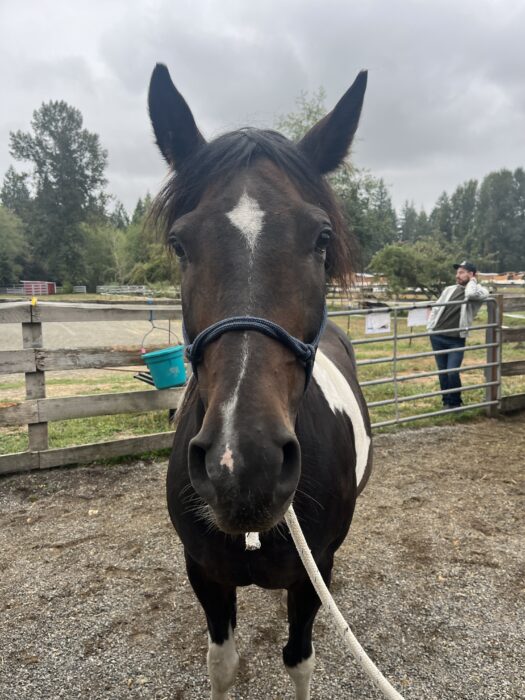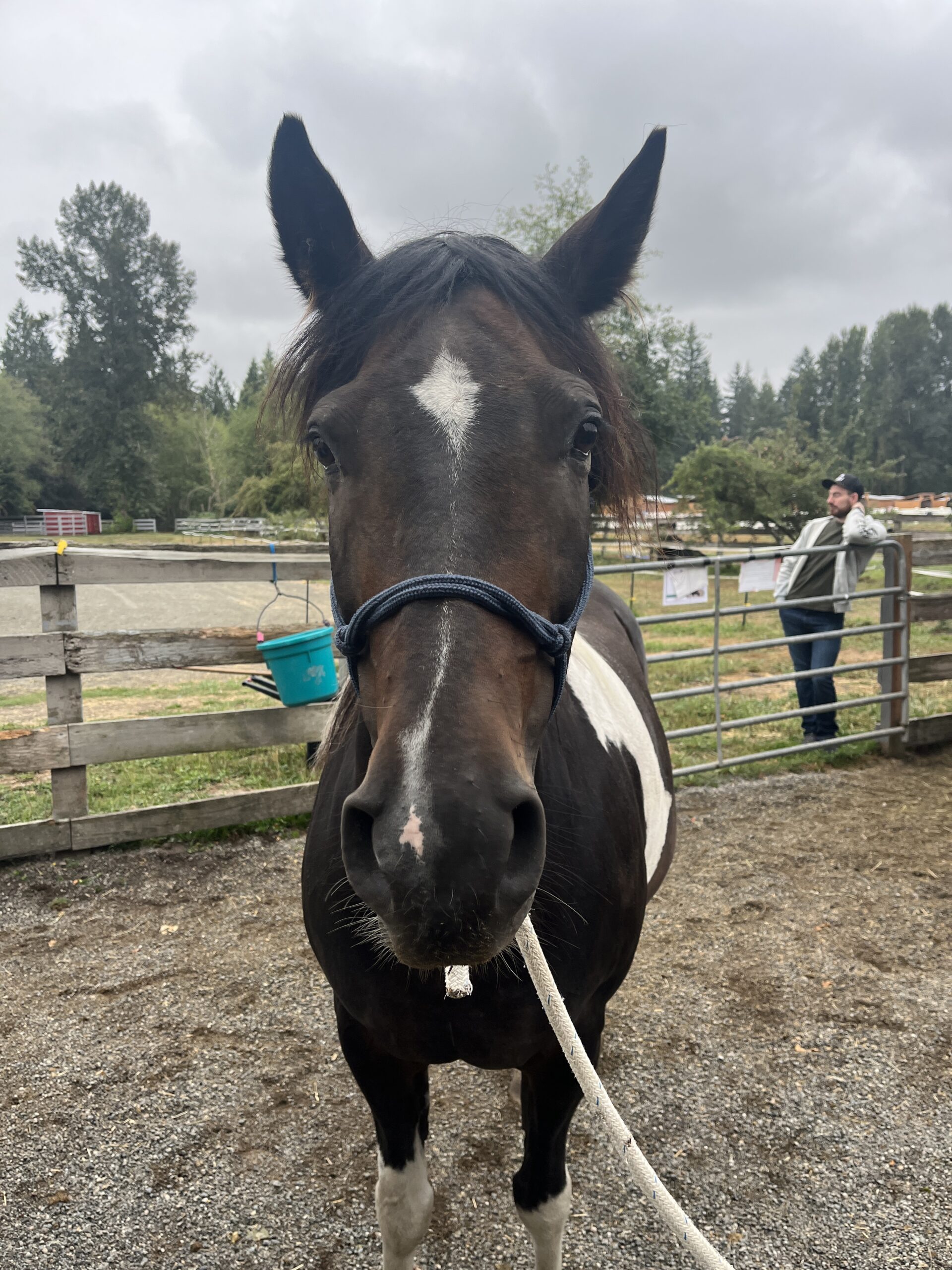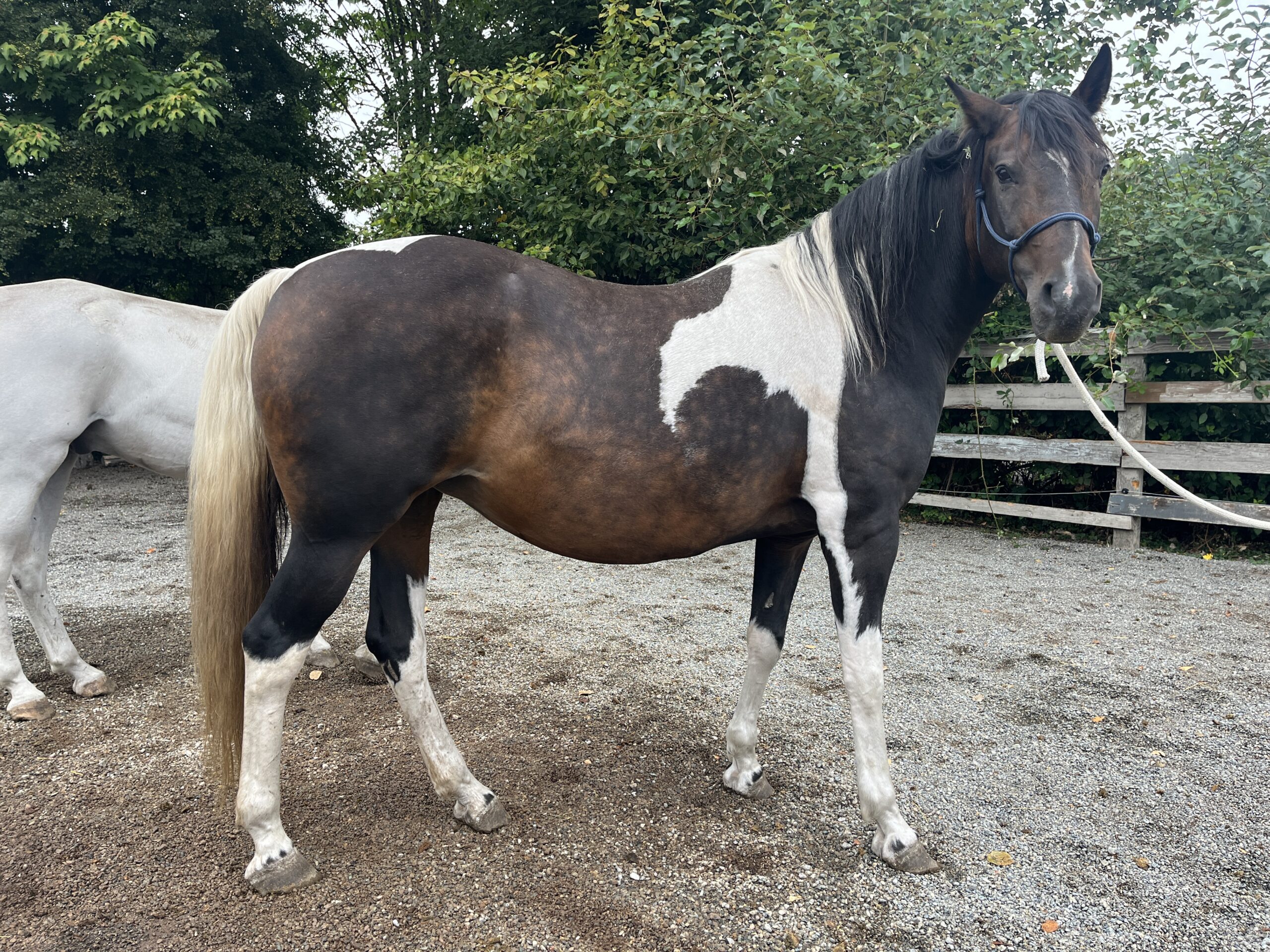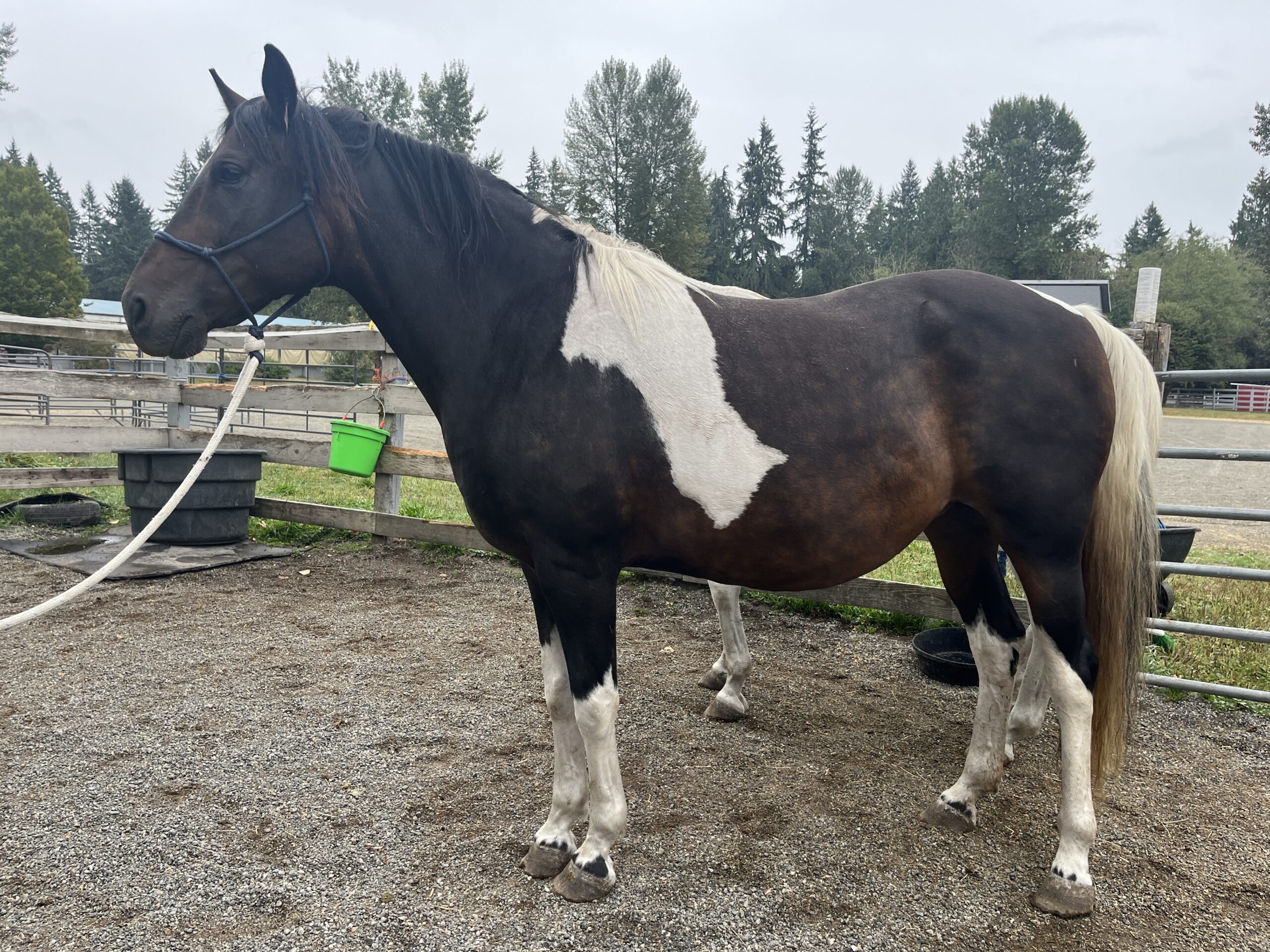Violet
2011 Arabian x American Indian Horse mare
Type of Rescue: Owner Surrender
Intake Date: 8/28/2023
Adoption Date: 3/27/2024
Length of Time with SAFE: 8 months
ADOPTED!! by Lexee N.
Violet came to SAFE in August of 2023 along with her half-brother, Scotty. The two were previously owned by a gentleman who passed away, leaving their care to his elderly wife. She reached a point where she felt unable to provide the horses with adequate care. With the help of her daughter, she contacted SAFE to see about assisting with both horses. Violet was previously started under saddle as a three-year-old but was not ridden since. She arrived at SAFE in need of a diet and overdue for some routine vet and farrier care, but our initial impression of her was of a nice mare with some basic foundational skills under her belt.
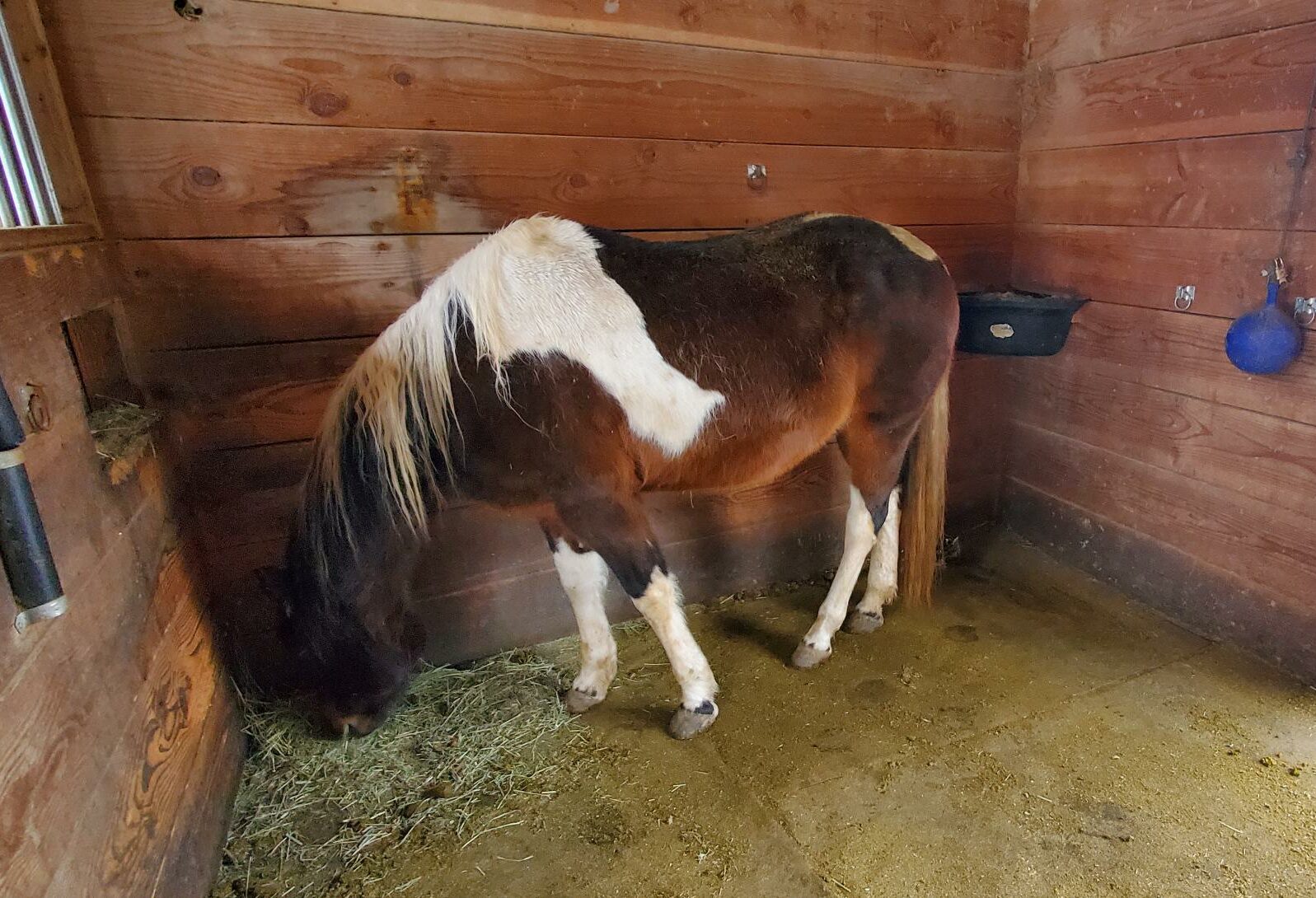
Alumni Update: Violet
We recently checked in with Lexee and Violet. Here is what Lexee had to share:
Violet has been such a great addition to my herd. She and Duke (my other horse) get along so great. Best friends at first sight. She also loves to run around with him and our minis, Bubba and Ginger.
She has been a fantastic trail horse, where we try to get out at least once a week. We’ve also continued working on our horsemanship in preparation for clinics. I’m excited to haul her around this summer to new places. Also, she and I will be at the August Joel clinic!
Here’s a couple cute photos of her with my best friend’s horse Primrose, who she absolutely adores.
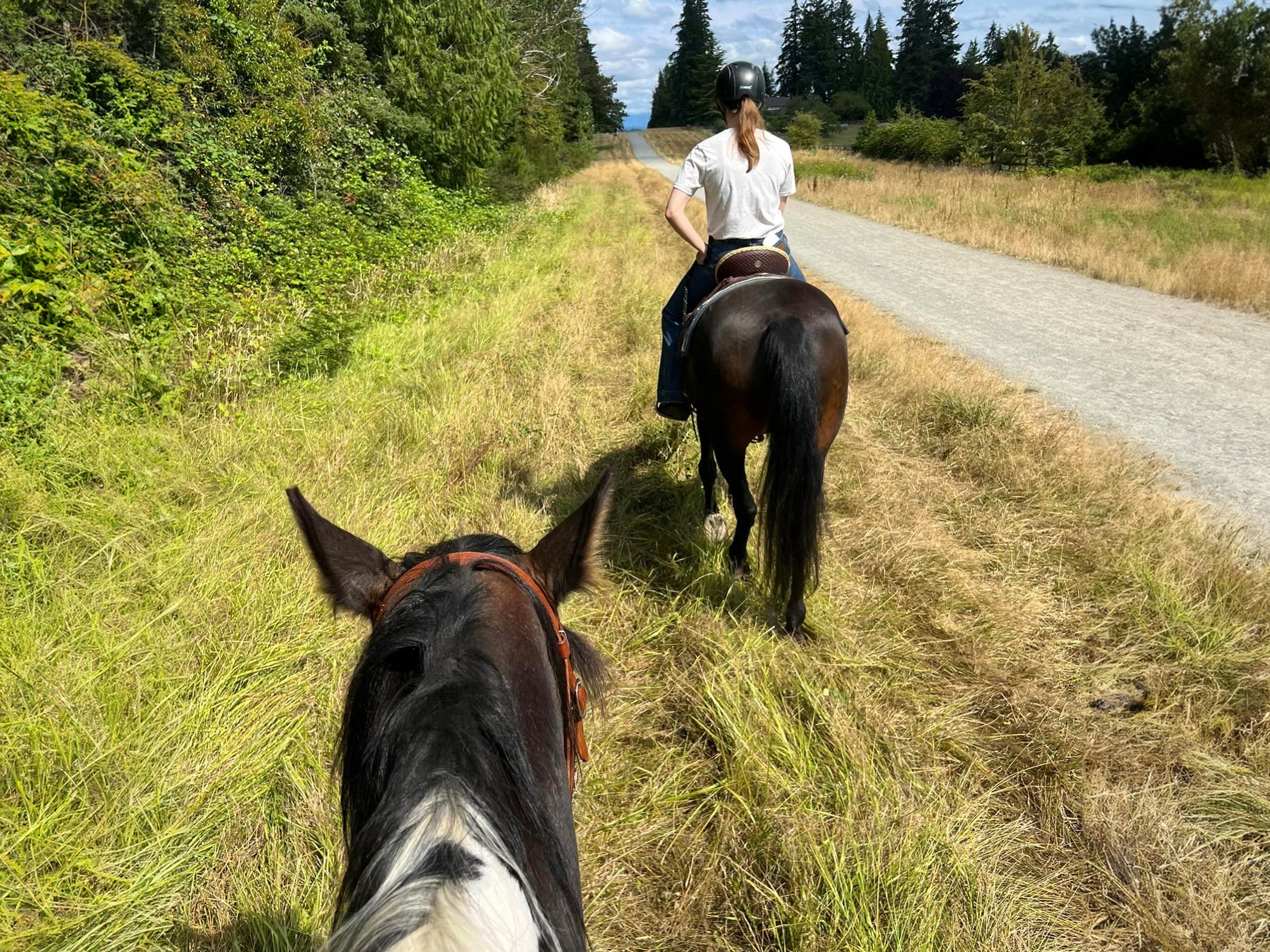
Alumni Update: Violet
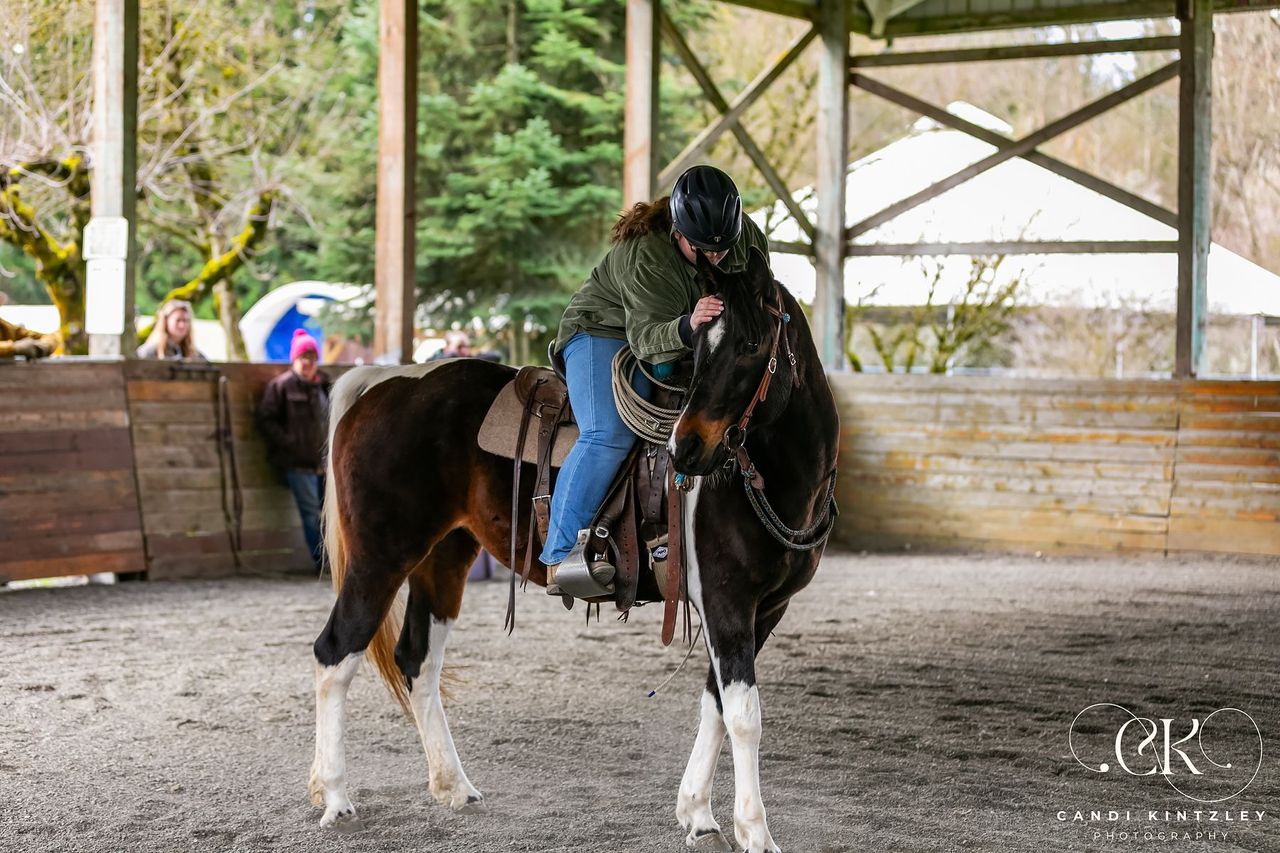
Violet is Adopted!
April showers bring May flowers, and they also bring adoptions. We are very pleased to say that SAFE’s resident flower, Violet, has been adopted to none other than long-term volunteer Lexee N! Lexee had been patiently awaiting her prince (or princess) charming to come through our gates to be a buddy to her horse, Duke. When Violet stepped off the trailer, sound, self-assured and beautiful to boot, we had an inkling that she might be the one.
Once she was off her intake quarantine, Violet and Lexee began working together. While she had been started in her youth, a number of years had passed since she was last under saddle, so the two of them had to start from scratch, more or less. Lexee helped prep Violet for a saddle and, when the time came, cinched her up for the first time. Along with Joel, Lexee put some of the first rides on Violet, and continued her education under saddle from that point forward.
The more time they spent together, the more their partnership developed, and it was not long before Lexee decided that Violet was the horse for her. After riding Violet in the March Joel Clinic, Lexee came to SAFE one afternoon with a trailer, loaded Violet up, and brought her home – after going through all the adoption checks, of course.
Since her homecoming, Violet has settled in perfectly well at Lexee’s. She has already caused the right amount of horsey-havoc, finding ways to escape her stall and redecorating her paddock, keeping Lexee and family on their toes. She and Duke were fast friends, and the two of them regularly romp around with Ginger and Bubba, their miniature horse siblings. The first ride Violet and Lexee had saw them rescuing a stuck lawnmower out of the mud, really proving how brave of a girl this horse is, and how much support she is able to gain through Lexee. This is truly a very special match!
When reached for comment, Lexee said: “It’s been cute that so many people (at SAFE) have told me they were happy I took her because they knew I would be able to help her find a new lease on life.” A new lease indeed! Congratulations, Violet! You have found a great place to bloom.
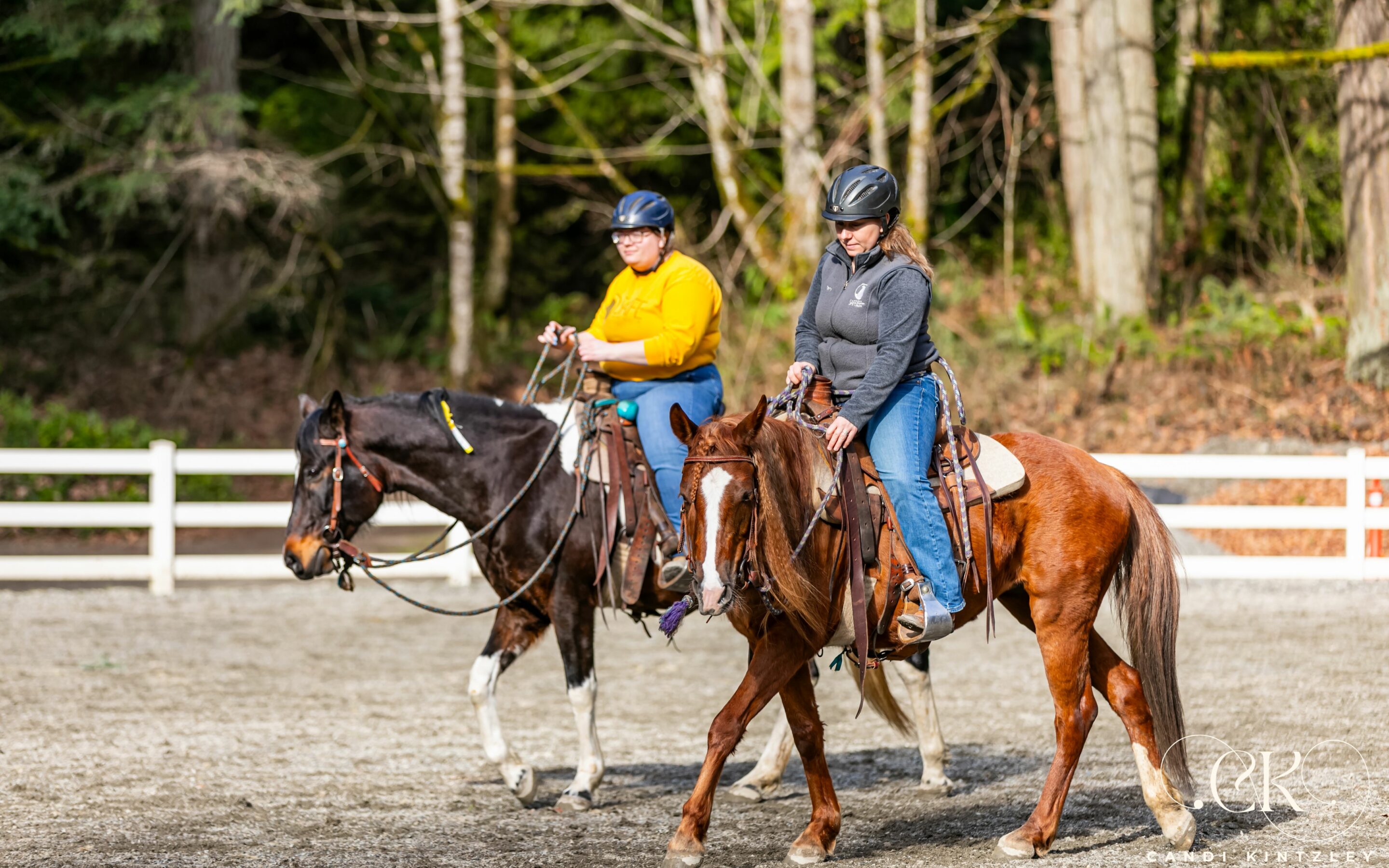
Field Trip to Bridle Trails
Winter Washington weather (say that five times fast) does not often conjure visions of sunshine and blue skies. But every so often, the metaphorical stars align to grace us with a January or February day that feels more akin to early summer.
Such was the luck we had for our first off-property excursion of 2024, a trip down the road to Bridle Trails state park. We loaded eight horses into the trailers: Alums Owen and Fancy accompanied current SAFE horses Artie, Veronica, Pepper, Tiva, Violet, and Edward. For the majority of the horses in attendance, it was the first time they had been away from SAFE since their arrivals, though you might not have guessed it by how coolly they greeted their new surroundings.
We unloaded horses and tack, and brought everything and one to one of the park’s arenas. There, we helped the horses settle into the new space through a combination of exploratory walk-and-sniffs (turns out, white vinyl fencing is snort-worthy) and groundwork. The time it took for each horse to settle varied some, though no one was particularly unsettled to begin with. Soon, everyone was cinched up, and we followed the sun into an adjacent arena.
All the horses currently going under saddle (meaning everyone aside from Tiva) had at least one, if not two or three, rides that sunny Saturday afternoon. Faced with strangers walking alongside the arena, some shepherding very interested dogs or children, as well as a stop-and-start parade of mounted riders heading out to the adjacent trails, our modest herd did tremendously well. They were able to find support in their humans when it was required, but for the most part handled the new environment and wide open arena space with level-headed grace. The countless hours that had led up to this point for each of them helped to make the entire outing hugely successful, and check some major boxes for our horses.
After several hours under saddle, basking in the sunshine and the glow of a very productive afternoon, we untacked the horses and grabbed our snack bags, retiring to a shady spot to allow for a physical and mental cooldown slash lunch break. The horses shook out their coats while they sniffed at our sandwiches, taking sips from the water buckets we’d brought as we all rehydrated for the short drive home. One stud muffin each was in order, the equivalent of your dad stopping for ice cream at the end of a road trip. Then, we loaded our tack and our horses, and headed back for SAFE in time for afternoon hay.
Though it takes some work logistically, we plan to take the horses off-site multiple other times this year, be it to clinics or for more casual adventures like our trip to Bridle Trails. We could not be more proud of the SAFE horses, and extend our thanks and gratitude to the humans who helped them, and continue to help them, in all stages of their journeys.
Check out a little glimpse of our day below:
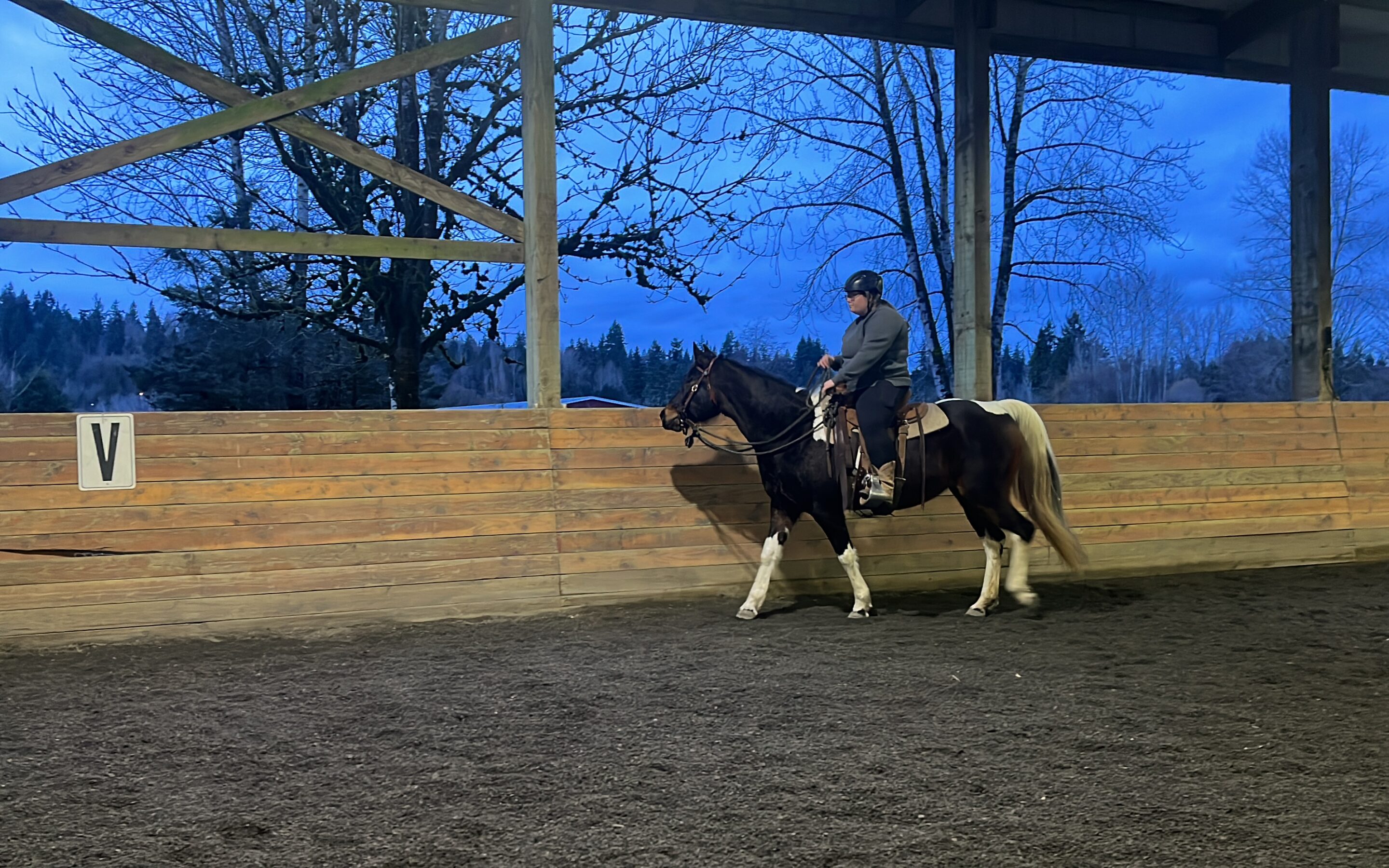
Violet in the Outdoor Arena
Early on in her tenure at SAFE, we marked Violet as brave. Not long after first stepping off the trailer, she was already leading the way on walks across the property, supporting her decidedly more nervous half-brother, Scotty. Her energy was self-assured, even in the face of a new environment, and we expected to see that only continue to increase as she entered into our training program.
Indeed, as Violet’s education both on the ground and under saddle grew, so did her confidence. It has been, all things considered, a relatively quick and mostly uncomplicated restart for Violet thus far. So when Lexee, who has been working with Violet, decided to take her out to the outdoor arena for her first ride in that space, we were mostly certain it would be a success. As it is with horses, nothing is ever 100% sure, but Violet’s cool nature paired with Lexee’s supportive presence seemed about the best combination for a positive first experience.
And it was! Positive, that is. First rides in a new space for a horse on the greener side of things are typically just a lot of bending and walking — no flying changes quite yet. Usually it is nice for a new horse to have the company of a buddy for their first few rides, but the way it happened was that Violet’s first was by herself. Having the support of her rider in the new space was enough for Violet, who took the experience in stride. She was definitely curious about the sights and sounds happening on the outside of the arena, but easily bent down in the few moments when she began to get a little too excited. Her first ride in the outdoor wasn’t particularly eventful, but that is exactly how we like it! After a few laps around the rail at a walk, Violet had officially checked another box on her training checklist.
I’d say there’s no stopping this mare, but that would be a lie — she is actually quite receptive to being stopped when asked, even in new environments!
Check out a clip of her first ride below:
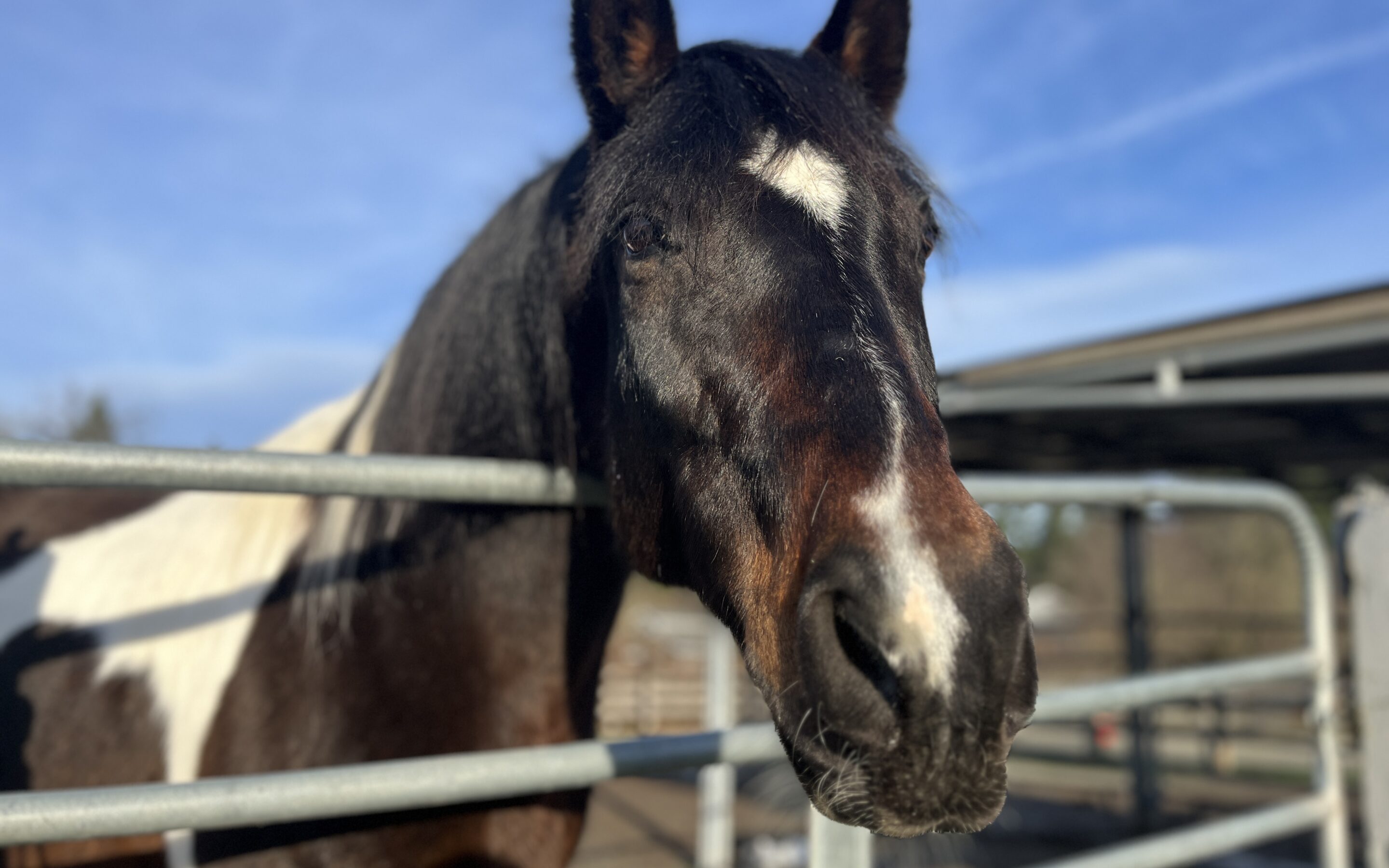
Training Update: Violet
After a relatively uneventful first ride here at SAFE, Violet has been going well under saddle for the past few months. She had been started in her youth, but because a good deal of time had passed and we knew little about what that start looked like, we took things nice and slow. Aside from some initial general misunderstandings (“what do you mean I have a hindquarters?”), and an overall lack of forward impulsion, Violet did not prove herself to be particularly troubled.
Lexee N, who took Violet on as a project from day 1, has also been the one to continue her education under saddle after those initial rides with Joel. The two of them have made great strides in helping Violet understand the ways in which she can move her body freely, and those early day “issues” Violet had are shrinking each time they work together.
Here is what Lexee has to say about Violet:
“Violet has been very impressive in her progression. Everyday she improves, and she is learning more and more that freedom in her feet not only feels good but also keeps her out of trouble. It’s actually getting tough to just have her walk around the rail, she’s really feeling forward and wanting to go. We’ve also explored the lope in the saddle. She’s a horse for whom balance makes a difference, and as she’s gets more and more balanced, you do see a noticeable differences in her strides. We just started working in the bridle and things seem to be going well. We are working in a loose rein and keeping light in our bending and continuing to get her freer at moving her hindquarters over.”
Here’s a video of one of Violet’s recent rides:
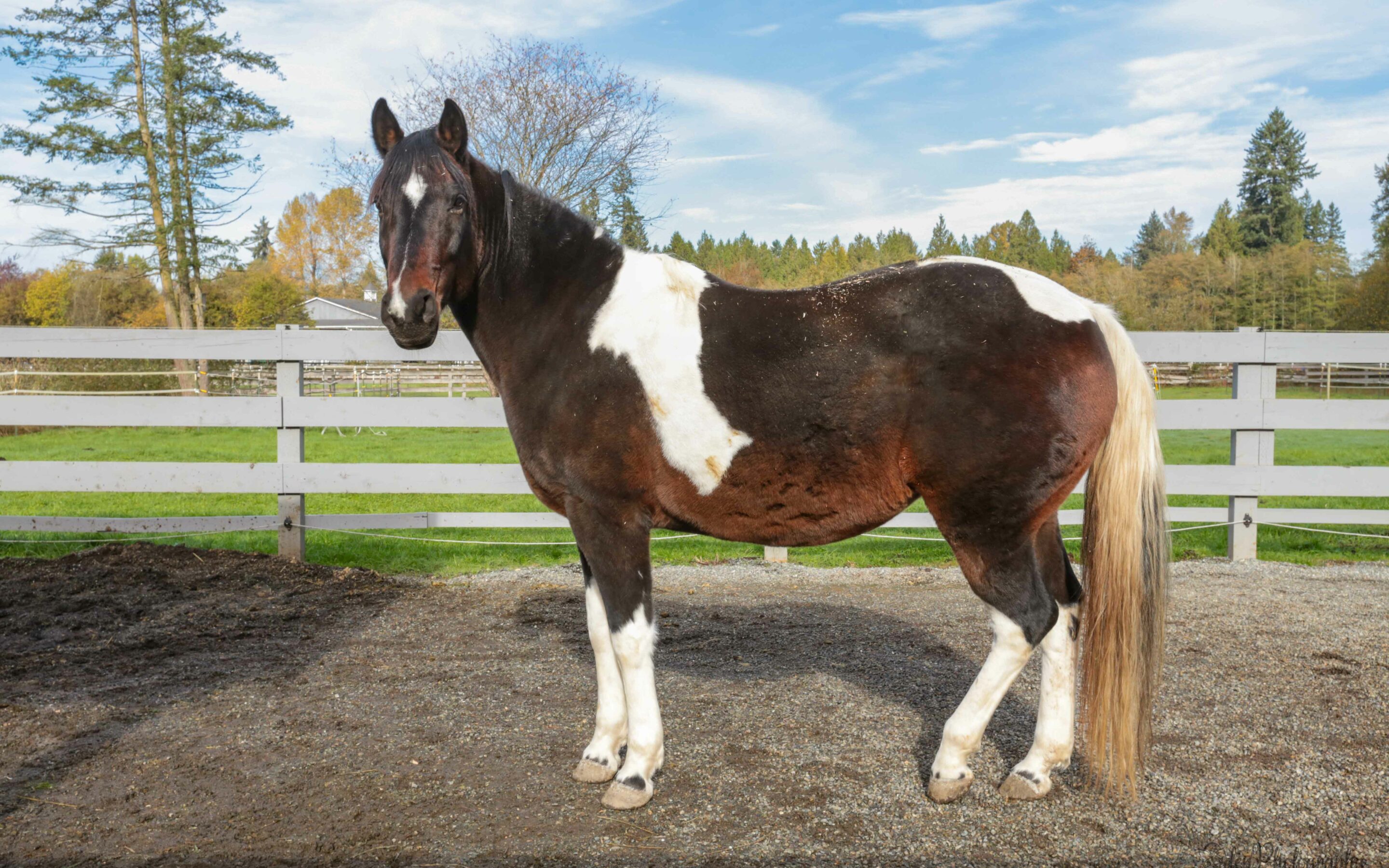
Getting to Know Violet
In getting to know Violet, we found two things to be true: she was in desperate need of a diet, and she was dull. Luckily, neither fact was without remedy. Over the last month, we have helped Violet shed a few lbs, and have already begun to see the true shape of the horse under all that extra adipose. Her body condition score might also be contributing to fact number two — it can’t feel particularly fun to move out when you are carrying around a few hundred pounds you don’t need. But ultimately, Violet is sluggish to respond to really any ask. We speak a lot about horses being ‘soft’ and having ‘life,’ which means they are quick and light to respond to the cues we give them. Not only is Violet in need of several reminders before taking us up on our original offer, but she often wears her ears back. This stink face also correlates directly to life, mostly just a lack thereof. Perhaps she was nagged at one point in her past, which in turn led to an unwillingness to move out. A horse who is never given a release for the correct behavior in turn learns not to expect one — why do anything when there is no benefit?
For a horse like Violet, the most important thing to teach her is that she will be given releases for doing what is asked of her. This is really the first step of the building blocks of training, for without life, you can accomplish very little.
We knew that Violet had been previously started under saddle in her life, but that it had been a number of years since that had happened. However, after our initial assessments, it didn’t seem as though Violet was particularly troubled. Aside from the aforementioned dullness, she wasn’t particularly bothered by very much, and she passed through our saddling checklist quickly and without issue. One of the main things would be helping her lose weight so the saddle would fit her better!
As Lexee N who is currently working Violet puts it, “she thinks she knows the answer to what is being asked, and is very confident in her (wrong) answer.” We use a metaphor here, black and white stones. Horses come to SAFE with a number of black (and white) stones within them. A horse pulls a stone to determine how they will react to something, be it a stimulus or a question being asked. Depending on the horse and their past, they may come with a great number of black stones, or very few. We try to instill in our horses as many white stones as possible with the hope that one day when they reach into themselves they will pull from that pile of white stones more often than the black. Violet has a lot of good try, and seems to be a fast learner, so we are hopeful that the day will arrive sooner than later when she answers what is being asked with the correct answer.
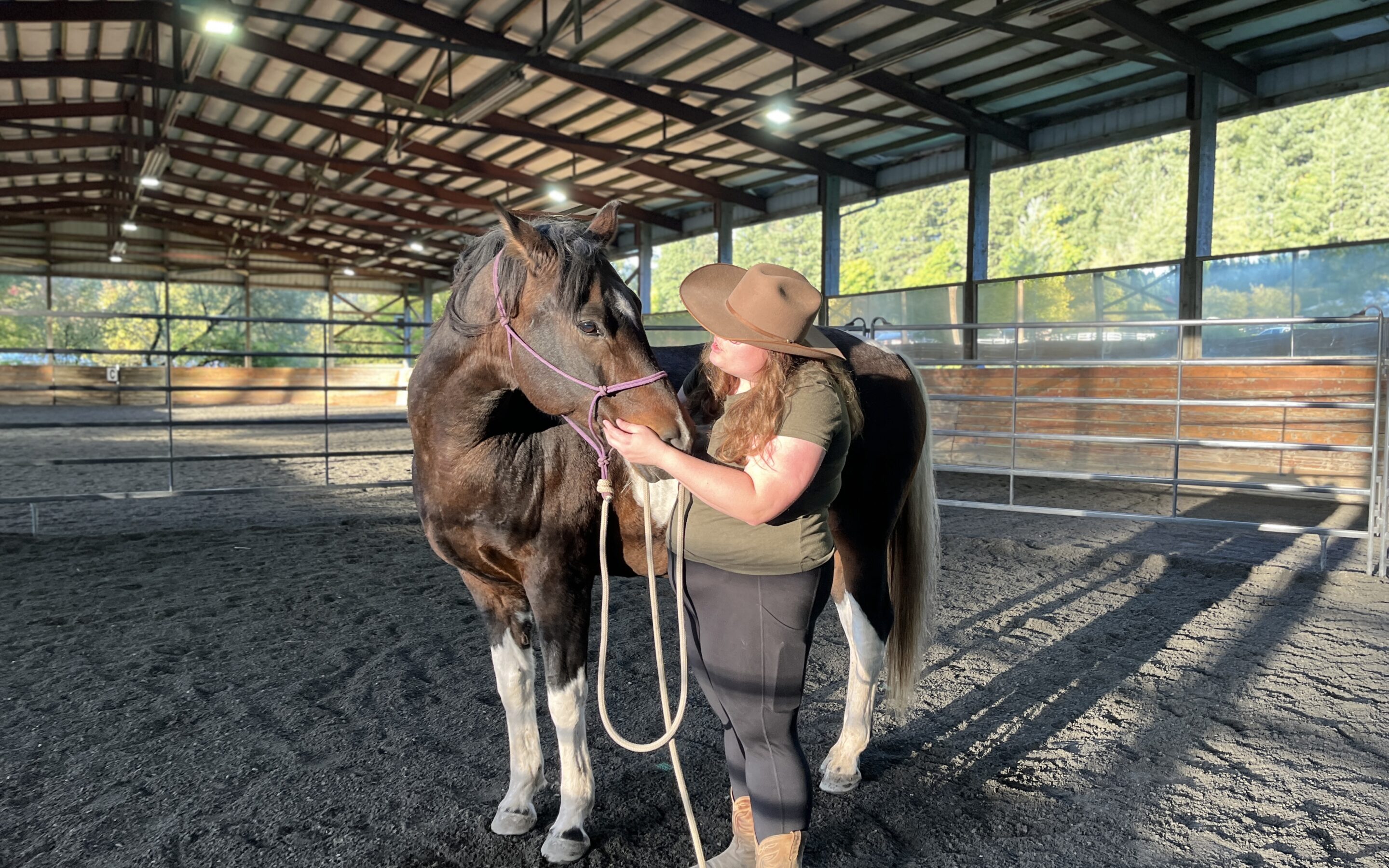
Violet Coming Along
Since her arrival at SAFE, Lexee N has been working with Violet to help her find freedom in her feet and life in her movements. The last few times Joel visited us, he worked alongside Lexee and Violet, and Lexee has the following to say about this beautiful mare:
“The lovely Violet has been a tough horse to get along with. She has a lot of resentment towards people and this reflects through her by being stuck in the feet and her tendencies to resort to biting or kicking. However, when shown the wonders of freedom of the feet her eyes open and soften, and she begins to trust the process. This mare has been set in her ways for the past 12 years of life and as amazing as this horsemanship is, it will take time to change her mind.
Everyday she gets lighter and softer in her movements and with her small but meaningful changes we were able to get our first rides on her. And although likely ridden before, the concept of human legs creating movement in hers was unbeknownst to her on the first ride with Joel. However, introduction to forward movement was only accomplished from movement of the flag from me on the ground. She slowly began to step forward, each time with less efforts from both Joel’s legs and my flag. We got her to move out at the walk and a few steps at the trot, introducing a bend to stop. Always ending with a good change for a dull horse such as herself.
Each day this built and built. She welcomed the good deal of Joel’s legs to both move forward and through the bend. To the point she felt safe enough for Joel to allow me to ride her. And with only riding her twice she has come through some huge strides where I can move her forward without an aid and around my leg. That said, we will continue to have me flagged around so I can be the good guy, just riding supple and relaxed with her through all movements to keep getting her more comfortable with a rider. She is a horse that would easily become irritated and could bite or kick out, and to keep things pleasant for the first rides we want to show her freedom of her feet moving forward is always the best answer. We want to always make the right thing easy, and with these small strides and short sessions Violet will be on her way out the doors in no time.”
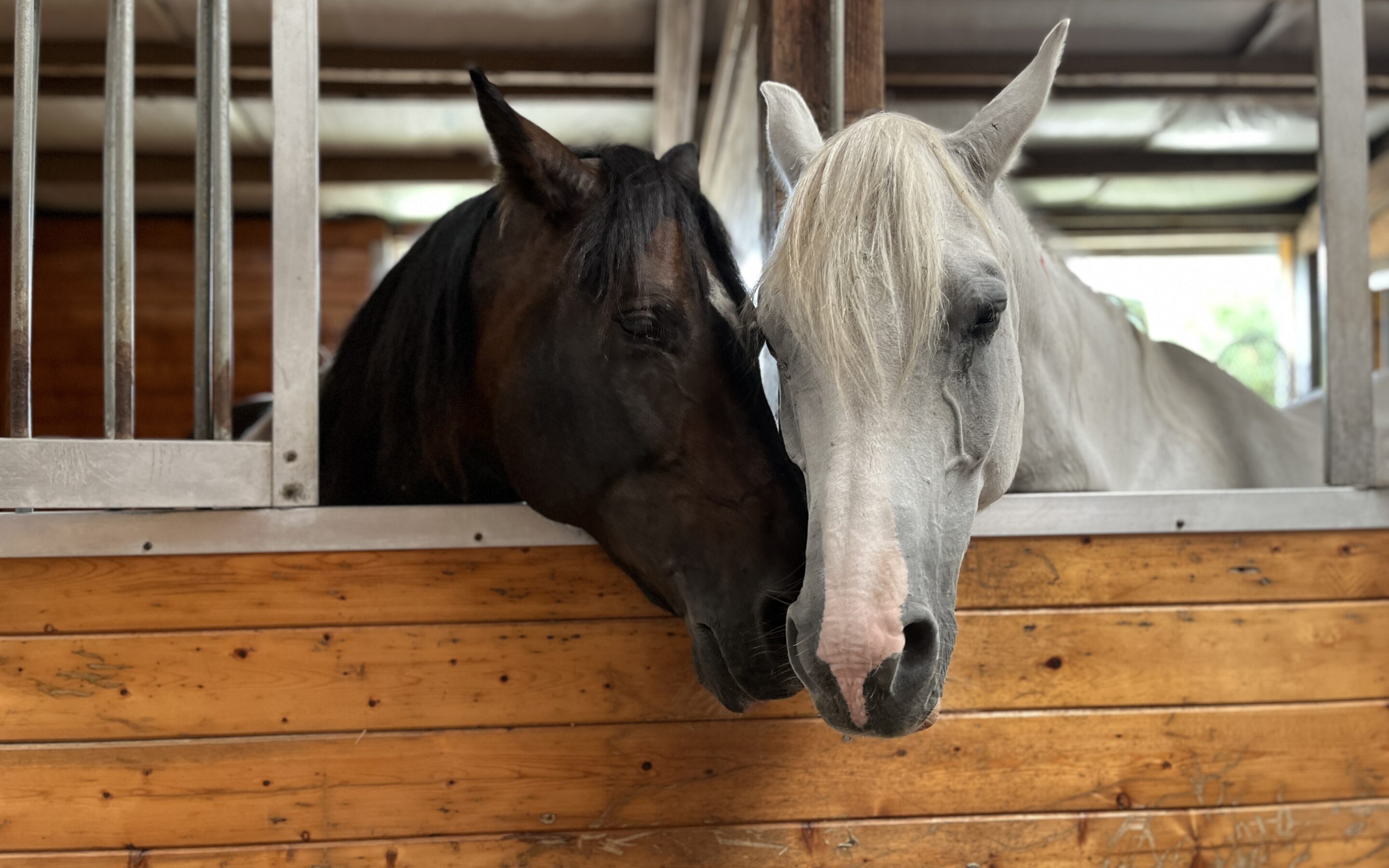
Violet and Scotty See the Vet
Here is an example of the stars aligning at SAFE: The Friday after Scotty and Violet’s arrival, there was a vet appointment on the books. Two horses needed floats, along with several who were due for one vaccination or another. Two dentals and a few pokes is a light day, especially with cooperative patients, so there is often a little part of us that seeks something (non-emergency) to tack on.. or, that if there is an emergency, it waits until the day the vets are already set to arrive. (These days, while rare, inspire us to run out for a lottery ticket, if just because the odds seem too good). So you might be able to see why, when Scotty and Violet arrived on the Monday of a Vet Week, it sent a tingle of hope along our very-fond-of-convenience spines. New horses, with the chance to almost immediately see the vet. But some boxes needed to be checked first, some questions answered.
Were they… halterable? Yes! A resounding yes, as they let us scoop their cute little noses right up into our halters that Tuesday with minimal fuss.
Okay, but were they… handleable? (not a real word, and one that moves around the mouth like a marble, but you understand) Also yes! Or, Yes* would perhaps be more appropriate, for there were certain spots on Violet that would have you risking a kick if you were to try and palpate. No matter, the important areas for a vet day (neck, head, heart) were all accessible, which left us with one final question: could we lead them into the barn?
Dear reader, something you may or may not already know about horses is that they are much like humans. In the comfort of their own homes, they are often gentle beasts, greeting you with either a kind curiosity or a tepid indifference. But when they are new, especially when they are new, they can be quite agoraphobic when it comes to leaving the house. As the gate clangs shut behind them, and they step further from the space they know so well, they begin to grow antsy, uncertain. If they are new, then they likely do not know what it is to find much comfort in their handler. Hindquarters? What’s a hindquarters? They bravely traverse into a whole new world, where unfamiliar horses call, wheelbarrows rattle from behind corners, and Sunny and Shasta.. exist. The sight of miniature horses, for most, before they become acquainted, can shake even (and perhaps especially) the most stout draft horse to its core.
So when it comes to being able to lead new horses into the barn, results may vary.
Violet and Scotty are both half siblings and very good friends. Violet made this very clear to us from day one, where as we flitted around Scotty, brushing the tangles from his mane and wrapping a tape around his belly to estimate his weight, she was in turn draping her head over his back and threatening to kick him. Classic horse love. But this kind of codependency can be detrimental, debilitating, and dangerous (the three D’s of herdboundness — look for my academic paper to be released later this year). In this case, what it meant was that if we were to remove Violet from Scotty, or vice versa, the two of them, stuck like glue, would not make things easy. And while herdboundness is important to address, for the sake of being able to get their dentals done in a timely manner, we decided to work smarter not harder.
Not as much of a mastermind plan as I’m making it out to be. Really what we decided on was bringing them in, together, and allowing them to essentially hold each other’s hand in the waiting room. This is not an uncommon technique — Brandy and Bandit get the same treatment, and Domino typically gets an emotional support Lacey when he has to see the good doctor (Lacey, on the other hand, needs no one but herself). So for the few days leading up to the appointment, we did our own leading up: Violet and Scotty, to the barn.
Violet almost immediately proved to us how secure in herself she was, walking out of the paddock on that first day like she’d been doing it her entire life. Scotty followed closely behind, his anxiety quickening his feet, but his mind remaining sound and sane, even in the face of Sunny and Shasta, as well as a pair of horses working in the arena who called out to them as they passed. These were not feral wildlings, these were horses who had likely spent a good deal of time in barns, but you know what they say about assumptions. We want to set our horses up for success whenever possible, and if that means over preparing them to walk into a barn, then so be it. Tuesday, Wednesday, Thursday we haltered them up and made the brief trek into the grooming stalls where we host our dentals. There, we stood and groomed on them to hopefully lead them to associate positive feelings with the space. We clicked pens into their necks, mocking up how their shots of sedation would go. For each little test we put them through, they did remarkably well, and we could all but feel them rolling their eyes at us as if to say, “yeah, we’re ready, can we go back to our paddock now?”
Friday came, moment of truth, and we lined them up. Scotty first, as he tended towards the more anxious, and we felt it would be a kindness to slip him his drugs first. As he grew sleepy, Violet stood patiently by, wondering if she might be able to pick out some of those pesky weeds around the front of the barn while she waited her turn.
Despite his 13 years, there was no record we had of Scotty ever having had his teeth floated. Another reason for the rush to get these two seen: who knows what was going on in that untamed mouth? It turns out, not that much. Scotty’s teeth, barring a few sharp points, were in pretty great shape. We chalked it up to good genes. At this appointment, he was also scanned for a microchip, and when none was found, implanted with one, tying him to SAFE forever. We got him up to speed on his vaccines, which he was several years overdue for, and gave his sheath a good clean while he was docile and sleepy.
Violet’s appointment ran very similarly to her half-brother’s: her own mouth hadn’t seen a drill since 2017, but it too was in good shape, barring those same minor points. She also received a microchip and an update to her vaccines. Because of her high body condition score, our vets also suggested we draw blood to check her insulin and her thyroid levels, just in case. While her thyroid was normal, her insulin was just slightly over normal range — a figure that our vet expected to come down with weight loss.
Apart from Violet’s (over)weight, our vet gave them both a clean bill of health. We brought them into adjoining stalls to come out of their sedation, where Scotty, who was slightly more awake having gone first, called to his friend as she stumbled in next to him. We opened their windows as to avoid any stressful messes, where the two quickly reunited. Nose-to-nose, they slept off their drugs together, where, when they were sufficiently awake, they made the trek back to their paddock.
Another health-keeping note: the intake fecal we ran on them revealed the highest fecal egg count we have ever seen here at SAFE. Violet had a count of 2,168 EPG and Scotty had a whopping 3,416 EPG! We wonder if some of those extra lbs on Violet couldn’t have been caused by the ever so delicious sounding “worm belly.” We have since dewormed the pair, and have been monitoring them extra carefully in the event that such a serious parasite extermination causes any health events. So far, so good, and we hope that at our recheck fecal in a few weeks we see those numbers way, way down.
In the meantime, barring any emergencies, Violet and Scotty can check seeing the doctor off their list for the next little while.
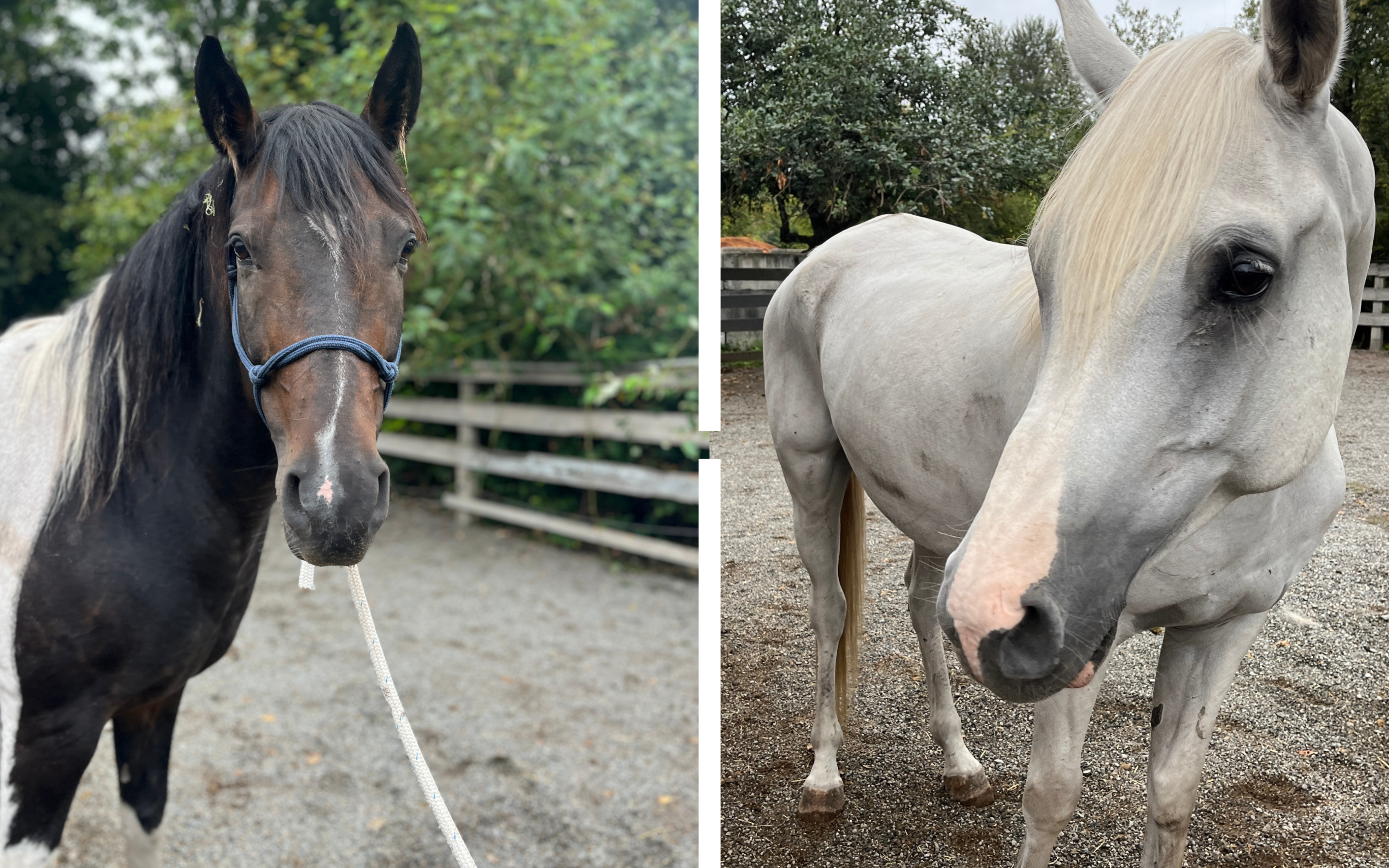
Welcoming Violet and Scotty
We have two new additions to our herd this week: Scotty, a 12-year-old registered Arabian gelding, and his half-sister Violet, an 11-year-old Arab cross mare. They came to us at the request of a daughter, whose elderly mother had been their caretaker after the death of her horseman husband, but who was no longer feeling equipped for the responsibility. The horses had both been out of work for a number of years, and were out of date on their vet and farrier care, but were not in too bad of shape overall.
We were under the impression that the mare would be difficult to catch, and therefore prepared our trailer with panels in the event that we needed to make a chute. But when we arrived at the property, we found her quite willing to be caught, and both horses loaded just fine.
Scotty, the gelding, is a registered Arabian gelding, who was born a chestnut but completely transformed in color as he aged. It’s hard not to see a light grey horse and not conjure visions of unicorns. Once we brushed the fairy tangles (a very polite way of saying major snarls) out of his mane, it did well to match this aesthetic too. Our first impressions of Scotty were of a slightly nervous horse, a little shy about being caught, but quite gentle. Unlike some horses, we knew a little more about his past — he had been started under saddle, and was ridden regularly until 2017. He has been out of work since then, but he seems to have a good head on his handsome shoulders, and we hope that he will be an easy restart in our training program.
Violet is a truly brick house of a mare — if not a 9 on the BCS, she’s a definite 8 point something. We don’t like to body shame around here, but a diet was definitely in order. Violet was also started under saddle once upon a time (when she was three, to be specific) but like her half-brother, she also appears to have a very solid mind. She has a tendency to pull a sour expression on people, but if you set a firm boundary (aka, ‘no, you’re actually not allowed to bite me’) we have found that she respects it.
On the heels of the Gig Harbor horses who arrived untouchable, it is a nice change of pace to have horses come in who have some good stuff in their past. We will see what we uncover as we go along and learn more about them, but regardless of all that, we love them already!

